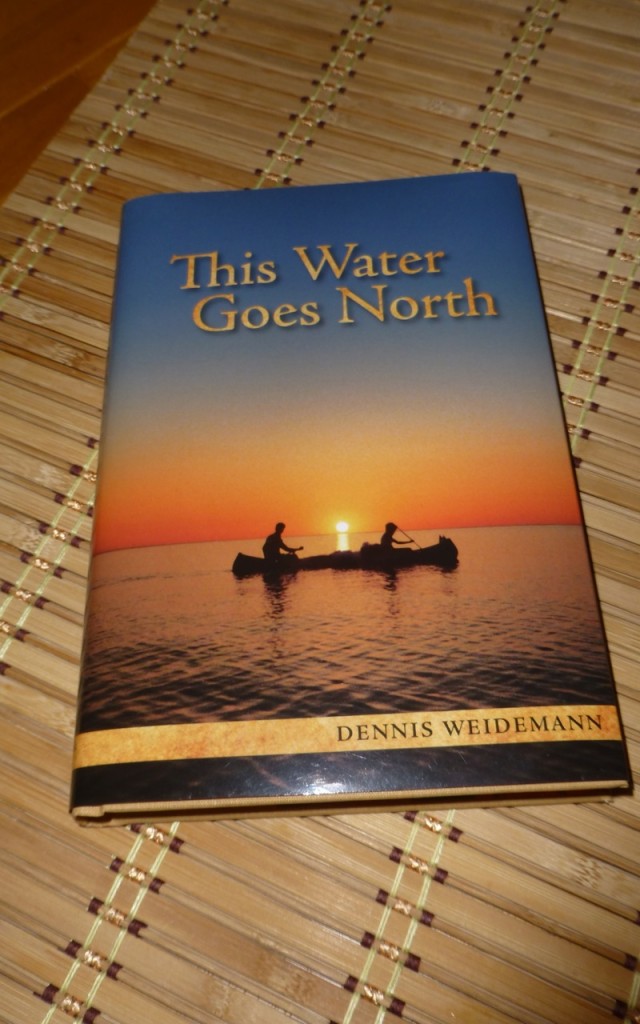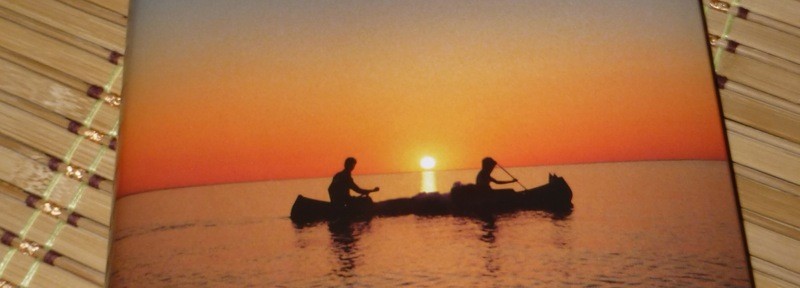If you’re interested in cuddling up with a good humorous midwest storybook, the book This Water Goes North, is the one for you.
I met the author, Dennis Weidemann, back in September 2012 when we went to a local fair in Afton, Minnesota. At that time, I purchased his book fully intending to read it “soon.” But, life happens and I didn’t get around to reading it right away. Then, after I read it, I purchased one for a friend then made a mental note to post a blog about it. A few months later — here’s the review.
The book is about four Iowa boys who, in the summer of 1979, venture out on a 1400 mile canoe trip to the old York Factory trading post at the mouth of the Hayes River in Canada. The author writes in the first person of the adventures, the people and the history of the locations they visit.
I’d like to share a few snippets of the book with you — things that I personally found amusing, interesting or profound. I highly recommend this book. It’s not religious in nature and the “uncut” tales are from the perspective of inexperienced young men. It has an honesty about their lives — something that a lot of people don’t talk about.
The young men set out on this journey from Fergus Falls, Minnesota on May 8, 1979 when the lake should be ice free.
So — here are just a few snippets (and sometimes a few of my comments) …
From Chapter 1 when the young men were planning what to take along on their trip –
- “we concluded that the proper number of socks is seven; two will be dirty, two wet, two on the feet, and one lost.” The young men had a sense of humor on this adventure and a sense of reality. One lost? Indeed.
- “Our lack of experience was more troubling to others than it was to us. Youthful optimism is often a by-product of ignorance, and in that we were experts.” Quite a truthful statement. When we’re young and inexperienced, we just do things because we want to do them — not because we are informed of what we are doing.
Chapter 2
- “Our budget came to about $900 per person, with the majority earmarked for airplanes and food. That left little for gear. We couldn’t afford new tents, canoes, or sleeping bags.” Â These young men could have lost their lives on this trip — foolishness or an education in life?
Chapter 3 — a canoe flips over but all survive –
- “Lacking heavy clothing, we futilely layered on T-shirts and sweatshirts, and even donned the coonskin hats that friends gave to us as a send-off. Goofy looking they were, but pride is for warm people.” They learned a lesson early on in their adventure. There are just certain things we have to do to survive — pride aside.
- “Finally starting to warm up, I made a feeble attempt to make light of the situation, thinking to myself that the words “wet,” “naked,” and “forty degrees” should never be used in the same sentence.”
Chapter 4 – The Red River and Fargo
- “The morning after the crash, we stepped out of the tents to find a thin blanket of snow covering everything. For a moment there was dejected silence, then one by one, we started laughing uncontrollably, especially at Hanks “drying” lures that were now caked with white. What else could go wrong?”
- “A short celebration of paddle waving honored our arrival on the Red River, and the rest of the day transpired in glorious sunshine. How different life is when painted by the sun’s pastel brush.” Â Tell that to all the people living in the Seattle area — the suicide capital of the U.S. – who live in misty clouds for many months out of the year.
Chapter 5 – Grand Forks, Oslo, Minnesota
- “At one point, Gene sighed, “I thought about doing something like that once, but never did.” In the brief silence that followed, it was clear he was searching to understand why he never went. This wasn’t the first time we saw this struggle, nor would it be the last.” There are many people who don’t follow their hearts leading into adventure. The What If’s in life can take a toll on a heart.
- “Rounding a bend one day, we came upon a dark shadow looming about fifteen feet up in a tree, wedged between two large limbs. It was much too big to be a squirrel. The trees were only just beginning to leaf out, so it wasn’t an abnormally dense layer of leaves. Getting closer, the shape became familiar. It was a cow!”
Chapter 6 – Crossing Into Canada
- “During one of our more interesting outings, to a natural history museum, we learned about the wildlife further north. Countless displays painted a picture of what lay ahead. Rounding a corner, I saw the others intently staring at an exhibit. “Weee doggies.” “That is one big mama.” “Ho-ly cow.” Curious, I peeked in their direction. When I caught sight of the display, my spine turned to liquid. It was a stuffed polar bear. Looking at the giant, I understood what it felt like to be somewhere below the top of the food chain. It was humbling, but edifying. Staring into the bear’s dark eyes, I felt foolishly arrogant and hopeful that those who see arrogance are less the fools of it.”
Hopefully that gives you a little flavor of the book. I’m not a history buff by any stretch of the imagination but enjoyed the snippets of history the book gave of different towns/areas where they traversed.
It’s simply a good read — at least for me it was. And, at one point I even thought to myself “Hmmm, could I take this canoe trip myself?” I wonder what husband would say about that! Â (laughing) Â
Or perhaps, in the new year, you’ll want to take your own adventure.

The author has a website also — This Water Goes North


